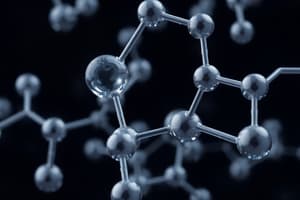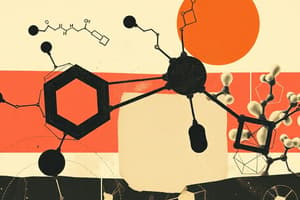Podcast
Questions and Answers
Carbon forms a bond with which of the following 4 elements?
Carbon forms a bond with which of the following 4 elements?
- Hydrogen (correct)
- Oxygen (correct)
- Nitrogen (correct)
- Phosphorus (correct)
- Sulfur (correct)
Why does carbon have a whole branch of chemistry devoted to it?
Why does carbon have a whole branch of chemistry devoted to it?
Carbon has 4 valence electrons allowing it to bond strongly with other elements.
What are macromolecules?
What are macromolecules?
Large organic compounds made from smaller molecules.
How are polymers formed?
How are polymers formed?
What is polymerization?
What is polymerization?
What are the 4 major groups of macromolecules?
What are the 4 major groups of macromolecules?
What are carbohydrates made of?
What are carbohydrates made of?
What is another name for simple sugars?
What is another name for simple sugars?
Give examples of monosaccharides.
Give examples of monosaccharides.
What is a disaccharide?
What is a disaccharide?
Give an example of a disaccharide.
Give an example of a disaccharide.
What is the function of carbohydrates?
What is the function of carbohydrates?
Plants, some animals, and other organisms also use carbohydrates for what?
Plants, some animals, and other organisms also use carbohydrates for what?
What supplies immediate energy for cell activities?
What supplies immediate energy for cell activities?
What are complex carbohydrates?
What are complex carbohydrates?
What supplies energy for muscle contraction and movement?
What supplies energy for muscle contraction and movement?
What do plants use to store excess sugar?
What do plants use to store excess sugar?
What are large biological molecules that are not soluble in water and made mostly from carbon and hydrogen?
What are large biological molecules that are not soluble in water and made mostly from carbon and hydrogen?
What is the major component of wood and paper?
What is the major component of wood and paper?
What are the most common lipids?
What are the most common lipids?
What is the function of lipids?
What is the function of lipids?
What are synthesized by the body and are lipids that serve as chemical messengers?
What are synthesized by the body and are lipids that serve as chemical messengers?
How are lipids formed?
How are lipids formed?
When a lipid's fatty acid chain is joined to another carbon by a single bond, the lipid is said to be what?
When a lipid's fatty acid chain is joined to another carbon by a single bond, the lipid is said to be what?
What does it mean when fatty acids contain the maximum number of possible hydrogen atoms?
What does it mean when fatty acids contain the maximum number of possible hydrogen atoms?
What do you call lipids whose fatty acid has at least one carbon-carbon double bond?
What do you call lipids whose fatty acid has at least one carbon-carbon double bond?
What do you call lipids whose fatty acid contains more than one double bond?
What do you call lipids whose fatty acid contains more than one double bond?
What do lipids containing unsaturated fatty acids, such as olive oil, do at room temperature?
What do lipids containing unsaturated fatty acids, such as olive oil, do at room temperature?
Compare and contrast saturated and unsaturated fats.
Compare and contrast saturated and unsaturated fats.
What are macromolecules containing hydrogen, oxygen, nitrogen, carbon, and phosphorus called?
What are macromolecules containing hydrogen, oxygen, nitrogen, carbon, and phosphorus called?
What are nucleic acids?
What are nucleic acids?
What do nucleotides consist of?
What do nucleotides consist of?
What play important roles in capturing and transferring chemical energy?
What play important roles in capturing and transferring chemical energy?
What do nucleotides do?
What do nucleotides do?
What are the two kinds of nucleic acids?
What are the two kinds of nucleic acids?
What macromolecules contain nitrogen, carbon, hydrogen, and oxygen?
What macromolecules contain nitrogen, carbon, hydrogen, and oxygen?
What are compounds with an amino group (-NH2) and a carboxyl group (-COOH)?
What are compounds with an amino group (-NH2) and a carboxyl group (-COOH)?
What bond links amino acids together?
What bond links amino acids together?
What is a functional molecule built from one or more polypeptides?
What is a functional molecule built from one or more polypeptides?
What controls the rate of reaction and regulates cell processes?
What controls the rate of reaction and regulates cell processes?
What is the sequence of amino acids called?
What is the sequence of amino acids called?
What do you call the folding or coiling of a peptide chain?
What do you call the folding or coiling of a peptide chain?
What is the complete three-dimensional arrangement of a polypeptide chain?
What is the complete three-dimensional arrangement of a polypeptide chain?
What are the four compounds found in living things?
What are the four compounds found in living things?
What is the function of nucleic acids?
What is the function of nucleic acids?
Why are proteins not lipids?
Why are proteins not lipids?
What does carbon's four valence electrons allow it to do?
What does carbon's four valence electrons allow it to do?
What are the 4 types of macromolecules?
What are the 4 types of macromolecules?
Flashcards are hidden until you start studying
Study Notes
Carbon and Its Importance
- Carbon bonds with oxygen, hydrogen, nitrogen, phosphorus, and sulfur.
- Four valence electrons allow carbon to form strong bonds, leading to a vast array of compounds.
- Carbon can create single, double, or triple bonds and even form rings.
Macromolecules
- Macromolecules are large organic compounds made from smaller molecules.
- Polymers are formed by joining monomers through a process called polymerization.
Major Groups of Macromolecules
- Four key macromolecule types: carbohydrates, lipids, nucleic acids, and proteins.
Carbohydrates
- Composed of carbon, hydrogen, and oxygen in a 1:2:1 ratio.
- Simple sugars, or monosaccharides include glucose, galactose, and fructose.
- Disaccharides, like sucrose, are formed by linking two simple sugars.
- Function primarily as a source of energy and structural support in plants and some animals.
Complex Carbohydrates
- Include large macromolecules formed from monosaccharides; examples are glycogen and starch.
- Glycogen provides energy for muscle contraction, while starch stores excess sugar in plants.
Lipids
- Large biological molecules that are hydrophobic, primarily made of carbon and hydrogen.
- Include fats, oils, and waxes, serving mainly to store energy.
- Steroids are lipid-based chemical messengers synthesized by the body.
- Formed from glycerol combined with fatty acids; can be saturated or unsaturated.
- Saturated fats contain only single bonds, while unsaturated fats have at least one double bond.
Nucleic Acids
- Comprised of hydrogen, oxygen, nitrogen, carbon, and phosphorus.
- Polymers made from monomers called nucleotides, which consist of a five-carbon sugar, phosphate group, and nitrogen base.
- Two main types: RNA and DNA, responsible for storing and transmitting genetic information.
Proteins
- Made from nitrogen, carbon, hydrogen, and oxygen.
- Composed of amino acids linked by peptide bonds.
- Function to control reaction rates, regulate cellular processes, form structures, and transport substances.
- Primary structure refers to the amino acid sequence, secondary structure involves folding or coiling, and tertiary structure is the three-dimensional arrangement of polypeptides.
Distinctions and Functions
- Nucleic acids store genetic information; their structures include nucleotides.
- Proteins play diverse roles in biological systems different from lipids, which are solely made of carbon and hydrogen.
Unique Properties of Carbon
- Carbon's four valence electrons enable the formation of diverse, complex structures with varying bond types and arrangements.
Studying That Suits You
Use AI to generate personalized quizzes and flashcards to suit your learning preferences.




